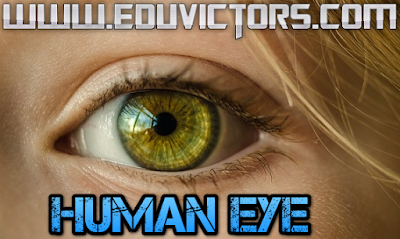About Human Eye - Questions and Answers

Human eye can be considered as an optical instrument. Light rays coming from the object to be seen enter the eye through Cornea and fall on the eye lens through the pupil of the eye.
Parts of human eye are:

Cornea:
The transparent spherical membrane covering the front of the eye.
Iris:
The coloured diaphragm between the cornea and lens. It gives colour to the eye.
Pupil:
The small hole in the iris.
Eye lens:
Its is a transparent lens made of jelly like material. It is a double convex lens forms a real inverted and smaller image of the object on the retina.
Ciliary muscles:
These muscles hold the lens in position.
Retina:
The back surface of the eye. Image is formed on retina. Retina contains cells called rods and cones to detect colour and intensity of the image.
Blind spot:
The point at which the optic nerve leaves the eye. An image formed at this point is not sent to the brain.
Aqueous humour:
A clear liquid region between the cornea and the lens.
Vitreous humour:
The space between eye lens and retina is filled with another liquid called Vitreous humour.
Q: What is persistence of vision?
Answer: The image of an object seen persists on the retina for 1/16 second even after the removal of the object. This continuance of sensation of eye for some timed is called persistence of vision.
Q: Define accommodation of an eye.
Answer: The ability of the eye to focus both near and distant objects, by adjusting the focal
length, is called the accommodation of the eye or the ability of the ciliary muscles to change the focal
length of the eye lens is called accommodation.
Q: What is the far Point of the eye?
Answer: It is the farthest point at which the object can be seen clearly. For a normal eye, the
far point lies at infinity.
Q: What is near point of the eye?
Answer: Near point of the Eye is the closest point at which an object can be seen clearly. For normal eye, the near point lies at 25 cm from the eye (least distance of distinct vision).
Q: Name the defects of vision.
Answer:
① Myopia(or) Short sightedness
② Hypermetropia (or) Long sightedness
③ Presbyopia
④ Astigmatism
Comments
Post a Comment